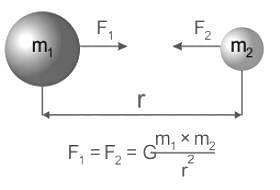Test: Universal Law of Gravitation - NEET MCQ
15 Questions MCQ Test Physics Class 11 - Test: Universal Law of Gravitation
The gravitational force on a body of mass m at a distance r from the centre of the Earth for r < R, where R is the radius of Earth, is proportional to:
| 1 Crore+ students have signed up on EduRev. Have you? Download the App |
The gravitational force between two objects each of mass m, separated by a distance r, is F. Gravitational force between two objects each of mass 2m separated by a distance 2r, will be
Two bodies with same mass “m” separated by a distance “r” exert a gravitational force of F on each other. Suppose the distance between them is doubled and the force becomes F’. The ratio of two forces is
The earth attracts the moon with a gravitational force of 1020 N. Then the moon attracts the earth with the gravitational force of
What is the force required to produce an acceleration of 9.8 m/s2 on a body of weight 9.8N? Take g = 9.8 m/s2.
The height at which the acceleration due to gravity becomes g/9 (where g = the acceleration due to gravity on the surface of the earth) in terms of R, the radius of the earth, is
The earth attracts the moon with a gravitational force of 1020 N. Then the moon attracts the earth with the gravitational force of
Both earth and moon are subject to the gravitational force of the sun. As observed from the sun, the orbit of the moon
Newton's law of gravitation is called universal law because:
As observed from earth, the sun appears to move in an approximate circular orbit. For the motion of another planet like mercury as observed from earth, this would
The gravitational force on a body of mass m at a distance r from the centre of the Earth for r < R, where R is the radius of Earth, is proportional to:
|
97 videos|378 docs|103 tests
|









 where, F is the gravitational force between bodies, m1, and m2 are the masses of the bodies, d is the distance between the centers of two bodies, and G is the universal gravitational constant.
where, F is the gravitational force between bodies, m1, and m2 are the masses of the bodies, d is the distance between the centers of two bodies, and G is the universal gravitational constant.





















